Discover the art of crafting a perfectly creamy fish chowder with our expert guide. Whether you’re a seasoned cook or new to the kitchen, this traditional recipe offers a rich, satisfying experience. Learn the secrets to achieving that luscious creaminess, explore the best fish options, and uncover expert tips to elevate your dish. From sautéing aromatic vegetables to selecting the perfect fish, this article walks you through every step to create a flavorful chowder that’s sure to impress. Dive in and unlock the keys to a delicious, hearty meal that’s as comforting as it is delightful.
Key Takeaways
– To achieve a creamy texture and rich flavors, master the art of combining traditional ingredients like fish, potatoes, onions, and cream.
– Fish chowder offers a thick, velvety consistency, unlike the brothy nature of fish soup, making it perfect for a hearty meal.
– Use a mix of spices such as bay leaf, thyme, salt, and black pepper to elevate the dish, while optional additions like Old Bay seasoning can add depth and color.
– Understanding the differences between fish soup and chowder helps you choose the right dish for your preferences, whether you want a clear broth or a creamy base.
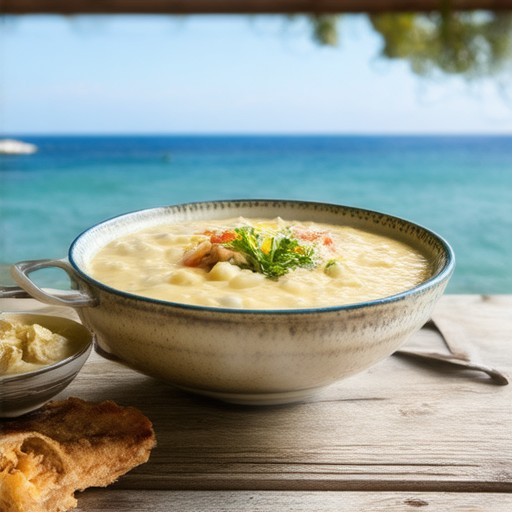
How to Make Seafood Chowder Creamy
To achieve a creamy texture in your seafood chowder, follow these steps:
- Main Ingredients :
- Heavy Cream : For a rich and velvety texture, heavy cream is the gold standard. It adds thickness and richness to the chowder.
- Half-and-Half or Milk : If you prefer a lighter version, use half-and-half or whole milk. A combination of milk and cream can also yield a balanced creaminess.
- Coconut Milk : For a dairy-free option, coconut milk is an excellent substitute. It introduces a subtle sweetness that complements the seafood beautifully.
- Optional Additions :
- Butter : Incorporating a little butter can enhance the creaminess and add depth to the flavor.
- Flour (Roux) : Creating a roux by mixing flour with butter or oil can act as a thickening agent, contributing to a smoother consistency.
- Tips for Success :
- Simmer Gently : Slowly simmer the chowder after adding your chosen creamy ingredient to allow flavors to meld and the texture to develop.
- Season Wisely : Enhance the dish with herbs, spices, and a touch of salt and pepper to elevate the overall taste.
By carefully selecting your ingredients and techniques, you can create a perfectly creamy seafood chowder that’s both delicious and satisfying.
What Kind of Fish Is Good for Chowder?
For a rich and satisfying chowder, opt for fish that are known for their firm texture and ability to hold up well in soup. These fish are mild in flavor, allowing the broth to take center stage while contributing a tender, flaky element to each bite.
Best Fish for Chowder
- Cod : A classic choice, cod is widely available and has a mild taste that pairs perfectly with chowder ingredients.
- Haddock : Similar to cod, haddock is another excellent option due to its firm texture and subtle flavor.
- Pollock : Known for its versatility, pollock is a great economical choice that works well in chowders.
- Salmon : While slightly firmer, salmon adds a luxurious touch to chowder with its rich, oily texture.
- Halibut : Halibut is a sturdy option with a delicate flavor that holds up well in soups.
- Snapper : Snapper is another excellent choice, offering a sweet, mild taste and a tender texture.
- Barramundi : A flavorful fish with a firm texture, barramundi is perfect for chowder recipes.
- Tilapia : Though often overlooked, tilapia is a great option for chowder due to its mild flavor and firmness.
Why These Fish Are Ideal for Chowder
Fish like cod, haddock, and pollock are popular choices because they are readily available, affordable, and have the right texture for chowder. Their mild flavors allow the other ingredients, such as potatoes, onions, and cream or milk, to shine through. Additionally, these fish don’t tend to release excess moisture when cooked, ensuring a thick, hearty consistency in your chowder.
How to Select and Prepare Fish for Chowder
When choosing fish for chowder, look for fillets that are uniform in thickness to ensure even cooking. Freshness is key, as older fish may have a stronger odor and affect the overall taste of the dish. For the best results, poach the fish gently in the chowder broth until just cooked through, preserving their texture and flavor.
Chowder Recipe Inspiration
Looking for a chowder recipe? Check out our classic chowder recipe for step-by-step instructions on how to prepare a delicious meal using the fish of your choice. Whether you’re making a New England-style chowder or a creamy variant, our guide ensures a perfect outcome every time.
Seafood Chowder Tips
- Add a splash of vinegar to the pot while cooking to enhance the depth of the broth.
- Use a heavy-bottomed pot to prevent the chowder from boiling too rapidly and splitting.
- Grate fresh nutmeg over the chowder before serving for a subtle, aromatic touch.
By choosing the right fish and following these tips, you can create a chowder that’s both comforting and memorable. Experiment with different varieties to discover your personal favorite!

How to Make Chowder Creamier
To achieve a creamier texture in your chowder, follow these expert tips:
- Use a Roux : Begin by preparing a roux, a mixture of butter and flour, to thicken your chowder. This classic technique adds body and creaminess.
- Incorporate High-Fat Ingredients : Use butter, bacon, or pancetta to increase the fat content, which enhances creaminess. Consider adding cheese like cheddar or Gruyère for extra richness.
- Add Cornstarch : As an alternative to flour, cornstarch is an effective thickener that won’t interfere with gluten-containing diets.
- Simmer Longer : Allow the chowder to simmer gently for extended periods to allow flavors to develop and the roux to fully thicken the broth.
- Finish with Milk or Cream : Stir in milk or cream near the end of cooking to prevent curdling and enhance creaminess without over-thickening.
- Avoid Over-Stirring : Stirring excessively can break down the roux, leading to a less creamy texture. Gentle stirring is key.
- Consider Potatoes : Incorporate potatoes into your chowder to naturally thicken it through absorption of liquids.
By combining these methods, you’ll achieve a velvety texture that defines a truly creamy chowder.
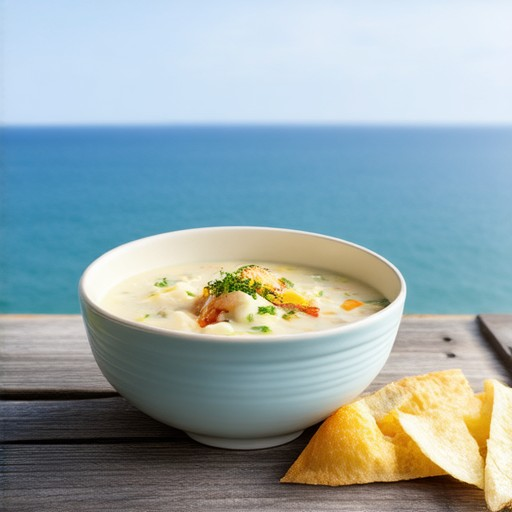
How to Make Simple Fish Chowder
To prepare a delicious and hearty simple fish chowder, follow these easy steps:
- Ingredients:
- Fresh fish (e.g., cod, salmon, or haddock)
- Water or fish broth
- Potatoes, peeled and diced
- Onion, finely chopped
- Carrot and celery (optional, for extra flavor)
- Milk or cream
- Salt and pepper to taste
- Instructions:
- In a large pot, heat a tablespoon of butter over medium heat.
- Add chopped onion and sauté until translucent. If using, add carrots and celery and cook until softened.
- Add diced potatoes to the pot and cook for a few minutes until slightly tender.
- Pour in water or broth and bring to a boil. Reduce heat to low, cover, and simmer for about 15-20 minutes until potatoes are fully cooked.
- Remove the potatoes and set aside. In a blender or food processor, puree the potatoes with a splash of milk or cream.
- Add the blended potatoes back to the pot along with the fish chunks. Simmer for another 5-10 minutes until the fish is cooked through.
- Stir in milk or cream and adjust seasoning with salt and pepper to taste.
- Serve hot, garnished with fresh herbs if available, and accompanied by crusty bread or crackers.
Enjoy your simple and flavorful fish chowder! For more seafood-inspired recipes, visit Only Fish Recipes .
What’s the Difference Between Fish Soup and Fish Chowder?
Fish soup and fish chowder are both delicious seafood dishes, but they have distinct characteristics that set them apart. Here’s a breakdown of their differences:
1. Texture
- Fish soup is typically clear and brothy , created with a base of stock or water and ingredients like fish, vegetables, and sometimes rice or noodles.
- Fish chowder, on the other hand, is thicker and creamier . Its texture is achieved through a roux (a mixture of flour and fat) or by using cream, giving it a rich, velvety consistency.
2. Ingredients
- Fish soup often includes seafood , vegetables , and seasonings like herbs and spices. Some versions may include rice or noodles .
- Fish chowder usually features seafood (like clams, shrimp, or cod), vegetables (such as potatoes, onions, and carrots), and a creamy base derived from butter, milk, or cream.
3. Serving Style
- Fish soup is often served hot and can be enjoyed on its own or with crusty bread or rice.
- Fish chowder is traditionally served warm and is commonly paired with crusty bread or a side salad for a hearty meal.
4. Examples
- Fish Chowder: Clam chowder is the most iconic, featuring clams, potatoes, onions, and a creamy base. Other variations include shrimp chowder and corn chowder.
- Fish Soup: Clear fish soup can be made with ingredients like white fish, mushrooms, ginger, and green onions, often served with rice or noodles.
By understanding these differences, you can choose the dish that suits your taste preference and dietary needs. Whether you prefer a light, brothy soup or a rich, creamy chowder, both are excellent options for seafood lovers!
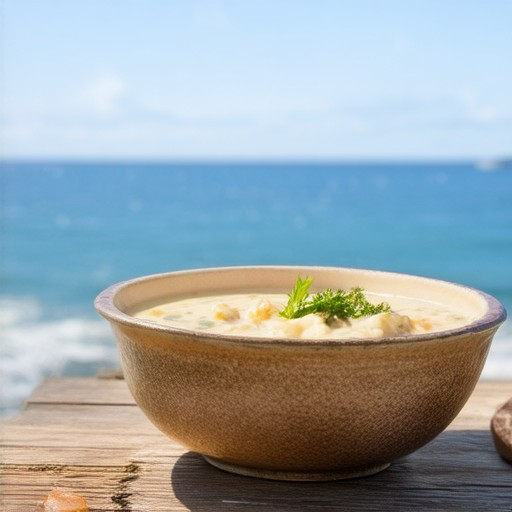
What Spices Are Used in Fish Chowder?
The New England Fish Chowder typically uses a combination of spices to enhance the flavor of the dish. Here’s a breakdown of the most common spices:
- Bay Leaf: Adds a subtle aromatic flavor.
- Thyme: Provides a herby note that complements the fish and vegetables.
- Salt: Essential for seasoning to bring out the natural flavors of the ingredients.
- Black Pepper: Offers a hint of heat and enhances the overall taste.
- Old Bay Seasoning: A popular spice blend that includes cayenne, paprika, and other spices, giving the chowder a distinctive red hue and a bit of warmth.
Some variations may include additional ingredients like garlic, onions, and celery, though these are more vegetable-based rather than traditional spices. For a sweeter touch, a splash of vinegar or a sprinkle of sugar can balance the flavors, though these are optional depending on the recipe.
For more detailed instructions and alternative methods, check out our seafood recipes collection or our specific fish chowder recipe .
Enjoy experimenting with these spices to create a delicious and hearty fish chowder!

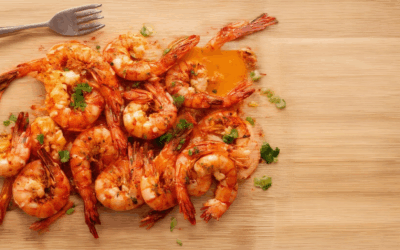
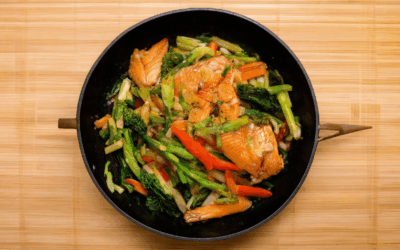

0 Comments